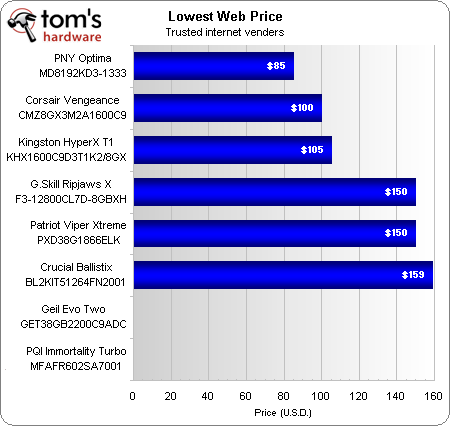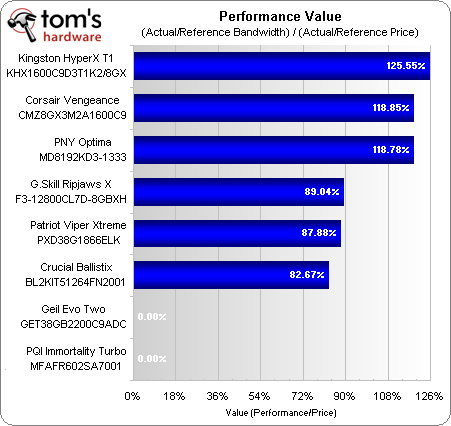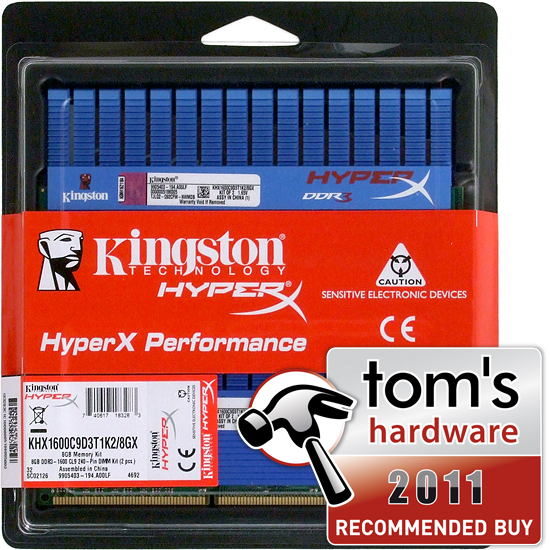Eight 8 GB (2 x 4 GB) Memory Kits For P67 Express, Rounded Up
Intel’s newest platform lineup has the same memory requirements as P55 Express, yet some of the modules available for it are rated differently. We discuss those differences on our quest to find the best performance/price in an 8 GB dual-channel kit.
Conclusion
Although it's the top performer in today’s comparison, Geil’s lack of U.S. availability makes it impossible to include in any value comparison, which obviously requires that we consider a price tag. That leaves Crucial’s middle-of-the-pack Ballstix DDR3-2000 as the highest-priced competitor in today’s roundup.
At the other end of the pricing scale, PNY shoots for best-value consideration with its low-cost DDR3-1333. It takes a lot of confidence to put mainstream parts up against such highly-rated competitors. Does that confidence pay off in a value win? We compared the maximum bandwidth of each module set to PNY’s reference-speed bandwidth (17.68 MB/s at DDR3-1333 CAS 9-9-9-24), then compared the price of each module set to PNY’s Web-price ($85). Dividing the first calculation by the second gives us value as performance-per-dollar.
Unfortunately for PNY, its low price isn’t enough to put it over-the-top when its maximum bandwidth exceeded its reference bandwidth by 18.8%. Kingston’s moderate price and high overclocking capability instead put it in the lead. Though we’ve always been a little shy about purchasing CAS 9 memory in hopes of achieving loftier overclocking results, Kingston’s margin of victory is large enough to earn its KHX1600C9D3T1K2/8GX kit one of our rare awards.
Though it didn’t reach the same DDR3-2133 frequency or DDR3-1866 CAS 8 timings, Corsair’s second-place Vengeance memory kit is even cheaper than Kingston’s HyperX T1. Futhermore, both products achieved similar timings at DDR3-1600. That makes Corsair a worthy adversary and an excellent alternative for buyers who wish to maximize performance at a moderate data rate.
Get Tom's Hardware's best news and in-depth reviews, straight to your inbox.
-
hmp_goose What happened to "get DDR3-1333 with tight timing: You'll never be able to appreciate `faster' stuff"?Reply
stuff rated 7-7-7-18 ment something, I thought … -
enforcer22 MMk sorry goose more ram is almost always and i mean 99.99999% better then faster ram :) i never saw any differences in ram speed turning off t1 and t2 timings slowing it down to a crawl turning off dual channel.. NEVER gave me an effective visual result. But adding more ram always gave me an instant result. I had this same argument with someone last week.. Nice to now have proof he was wrong about faster ram meaning something :) My ram is rated at 1600 but i have it only set on 1333 :/Reply -
dalauder My DDR3 2000 CL9 runs @ 1915MHz CL6 just fine. And I had some DDR2 800 @ 1010MHz & DDR2 533 @ 727MHz. I think most RAM just OC's nicely. I've also had a few weaker sticks (DDR2 667 that can't go over 727MHz), but it all exceeds posted specs.Reply -
CyberAngel I'm expecting to get my 2*4GB + 2*4GB DDR2 800MHz this weekReply
BUT
If I could do it over again I'd get that overly expensive DDR3 motherboard and just 1GB of RAM then later add more RAM sticks
Whenever DDR4 comes I'll jump in with small sticks and upgrade to more RAM when it gets cheaper (due to 20nm->15nm shrink)
Well, that's when Windows 9 arrives and 16 cores is the mainstream (2017?) I hope I have enough money for 3D projector at QuadHD, 4feet by 8feet white wall... -
Onus I would like to have seen something like the G.Skill Value series tested, but it really looks like RAM just doesn't make all that much difference for games.Reply -
ubercake I know this wasn't the primary focus of the article, though it is a good example of how sending more juice to your RAM and upping the speed on it has no noticeable effect on gaming performance.Reply -
gaborbarla ubercakeI know this wasn't the primary focus of the article, though it is a good example of how sending more juice to your RAM and upping the speed on it has no noticeable effect on gaming performance.Agreed,Reply
I would like to see a cheaper stick thrown in there like my Kinston Standard 512M X 64 Non-ECC 1333MHz 240-pin Unbuffered DIMM (DDR3, 1.5V, CL9, FBGA, Gold)
These RAMs with 19" Alloy wheels dont really seem to be worth their pricetags.
I think it is safe to say it is better to spend money on a better graphics card or CPU, perhaps a PSU.



